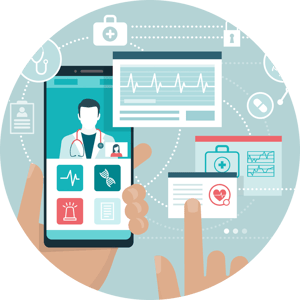HIT Perspectives
Subscribe
HIT Perspectives – August 2023
Life Sciences’ Next Opportunity: Supporting Clinical Champions with EHR Optimization
 By Brian Bamberger, Practice Lead, Life Sciences
By Brian Bamberger, Practice Lead, Life Sciences
Quick Summary
- Electronic health records (EHRs) feature tools and solutions that, if designed, implemented and customized according to end-user needs, can improve clinical and administrative workflows and may improve patient outcomes.
- While alert fatigue shouldn’t be completely disregarded, studies now show that a well-designed EHR alert and corresponding intervention can attract a provider’s attention rather than interrupt it, add value rather than overwhelm, and lead to evidence-based, guideline-recommended treatment that improves outcomes.
- Life sciences companies can support providers by customizing their EHR experience/workflow so that interventions, alerts and other resources appear at the right time, in the right context and do it compliantly.
- Life sciences stakeholders shouldn’t miss out on the opportunity to help providers understand how they can optimize EHR workflows; doing so may not only help to improve patient outcomes and reduce provider burnout but also help companies stand out in the marketplace.
In today’s fast-paced world of healthcare technology development, electronic health records (EHRs) may seem like old hat. Innovations like generative artificial intelligence may grab headlines, but it is the EHR that serves as the foundational tool upon which these newer, supportive technologies are built or layered. It’s important to recognize that EHRs are so much more than a repository of a patient’s clinical history. They have evolved into conduits through which actionable support can flow, assisting providers with their daily workflows by operationalizing existing activities.
When designed, implemented and customized according to end-user needs, EHRs can improve clinical and administrative workflows and, in some cases, patient outcomes. Health information technology (health IT) developers and internal hospital IT teams can integrate medication interaction alerts, reminders, order sets, documentation templates, evidence-based guidelines, and other resources, but their efforts will come to naught if these additional solutions wind up taking providers out of their workflow.
Life sciences companies (including pharmaceutical and biotechnology companies) are perfectly positioned to support providers in understanding how to customize their EHR experiences so that supportive tools appear at the right time, in the right context. Subject matter experts/account managers within life sciences organizations can support clinicians to better understand how they may optimize their workflows for a particular disease state or tweak an alert so that it’s more supportive of a particular treatment pathway. Now more than ever, EHRs and optimized interventions are perhaps the most important technological tools providers have when it comes to providing quality care.
Better Understanding the Cause of Alert Fatigue Is Helping Overcome It
To best understand the role life sciences companies are poised to play in optimizing EHR alerts, let’s first address the idea of alert fatigue – a very real phenomenon that occurs when clinicians are inundated with inappropriate alerts during their time charting in the EHR. A 2017 Weill Cornell Medical College study of alert receptiveness by physicians working within a network of federally qualified health centers found that end users became less likely to accept and act on alerts as they received more of them, and that between 49% and 96% of alerts were overridden, leading study authors to infer that most alerts were ineffective.
While some headlines over the ensuing years have reinforced the notion that alert fatigue diminishes the effectiveness of corresponding support tools, let’s not throw the baby out with the bath water. When optimized correctly, EHR alerts and interventions may help providers improve patient care. More recent studies show, in fact, that prompts appearing at the right time for specific patients are of benefit to clinical decision making at the point of care.
Readers may remember the Choosing Wisely initiative developed several years ago by the American Board of Internal Medicine. Designed to encourage conversations between physicians, patients and family members about avoiding unnecessary medical care, the effort included a study on the efficacy of alerts designed around Choosing Wisely principles. Conducted by researchers at Cedars-Sinai Medical Center, the study found that patients experienced fewer complications, incurred lower costs, left the hospital sooner and were less likely to be readmitted when physicians followed Choosing Wisely recommendations brought to their attention by alerts that popped up when their care instructions differed from evidence-based guidelines.
Additionally, researchers at the Yale School of Medicine set out to prove the power of well-designed alerts and supporting interventions during a seven-month study of 1,310 heart failure outpatients in 2021. They found that targeted and tailored EHR alerts recommending guideline-directed medical therapy (GDMT) to eligible patients increased the number of GDMT classes prescribed when compared with usual care regimens. Nearly 80% of providers said the alert was effective at enabling improved prescription of medical therapy for those patients. Not only was the customized alert effective at guiding physicians to more tailored therapies, but, as the Yale researchers pointed out, the intervention is of low cost and can be integrated fairly quickly into clinical care.
More recently, a Department of Veterans Affairs‒backed study presented at this year’s American College of Cardiology Annual Scientific Session showed that physicians caring for patients with heart disease were more likely to prescribe guideline-recommended, high-intensity statin therapy if they received an automated reminder about the patient’s disease history, statin use and history of statin-related adverse effects. In the study, the proportion of patients prescribed high-intensity statin therapy increased by 3.8% across all clinics in the intervention arm compared with the usual care arm, and that proportion increased by 10.1% among the subset of patients who were featured a reminder in the intervention arm.
“A 10% increase in high-intensity statin use is very meaningful at a healthcare system level given the challenges associated with this issue as shown in several studies. We found that if you’re able to send reminders that have information that is personally relevant to the patient, it works,” says VA researcher and cardiologist Salim Virani, MD. “Our results show that for every 10 reminders sent, healthcare systems can expect one patient with cardiovascular disease to be initiated or titrated to high-intensity statin therapy. Our data also show that it is important to be mindful of how reminders fit in with the clinical workflow to avoid creating alert fatigue.”
Ultimately, a well-designed alert and corresponding intervention should — and can — attract a physician’s attention rather than interrupt it, add value rather than overwhelm and lead to evidence-based, guideline-recommended treatment that improves outcomes.
EHR Optimization’s Perfect Pairing – Provider Champions and Life Sciences Expertise
Some within the industry may point to inadequate EHR training and/or workflow optimization as contributing factors to the misconceptions around the effectiveness of alerts. It’s no secret that some EHR end users are slow to adopt new functionalities for a myriad of reasons – whether that be through lack of offered training, an inability or lack of desire to take advantage of training resources related to new EHR functionalities or simply because a busy clinician assumes he or she will learn it on the fly.
In many healthcare settings, it takes a clinical champion for change to bring new EHR tools, particularly those related to supportive interventions, to the attention of other end users and IT decision makers. This is especially true when advocating for tools that may be available through an EHR vendo, but not yet implemented as part of a particular health system’s iteration of the software. This is an area ripe for an expert helping hand from life sciences companies.
They could, for example, offer insight into a healthcare organization’s EHR optimization cycle or the process by which they develop and test EHR-based initiatives. An often-used approach, known as the Plan-Do-Study-Act (PDSA) method, allows health IT developers and provider organizations to determine how effectively an alert or intervention is working in a specific setting, tweak the intervention’s settings to achieve different results or shelve the intervention in favor of going back to the drawing board. The most valuable insights can be gleaned from those clinical champions who are a part of the PDSA process sharing their in-the-trenches insights into the clinical value of proposed interventions.
By providing supporting information, life sciences companies may play a helpful, brand-agnostic role in optimizing EHR alerts and interventions. They may help providers formulate what they want to get out of their EHR systems, given their expertise in disease states and evidence-based treatment guidelines. More specifically, life sciences companies may help clinicians understand how they may optimize EHR intervention functionality by:
• Helping providers articulate to their internal EHR team what functionality they need from the software.
• Lending expertise in a particular disease state.
• Providing studies on effective interventions.
• Offering resources and education to position pharma touchpoints as trusted resources on evolving EHR capabilities.
Vanderbilt University Medical Center’s (VUMC) grassroots Clickbusters initiative offers a timely example of the lengths provider champions will go in order to eradicate alert fatigue and improve uptake. During the course of the program, launched several years ago, volunteer Clickbusters reviewed 84 alerts and reminders, ultimately turning off 10 and modifying 42. Their efforts resulted in over 71,000 fewer alerts being sent per week – a 15% total reduction in interruptive alerts. In analyzing the program, VUMC staff noted that Clickbusters “could be readily replicated at other clinical sites and applied to other functions of the EHR, such as order sets, clinical documentation tools and information displays.”
While VUMC’s analysis did not make specific mention of input from outside experts, the Clickbusters program highlights the optimization opportunities available to life sciences companies looking for ways to offer additional value to providers and their patients. Life sciences expertise can help EHR end users adhere to healthcare’s “Five Rights” concept by informing system changes so that the right information is presented to the right user through the right channel in the right intervention format at the right point in the workflow.
Competitive Advantages (and Supporting the Goal of Improved Patient Care) Await
Alerts and interventions hold potential in terms of advancing patient care, increasing physician productivity and reducing burnout. Life sciences companies willing to share their expertise can not only help to exponentially increase that expertise but gain a good-will advantage in the marketplace that may just help them stay one step ahead of the competition.
Point-of-Care Partners (POCP) works with numerous life sciences organizations interested in becoming a trusted resource for EHR workflow optimization within provider organizations and is ready to help your organization do the same. As POCP subject matter experts have pointed out before, the failure to identify, analyze and act on this type of opportunity will leave a life sciences company behind in the marketplace, potentially unable to effect change for the good of physicians and their patients.
If your organization would like to learn more about how best to support EHR end users in the areas of clinical alerts and interventions in a compliant way, visit our website for more information about how we can help or contact us to set up a meeting. We have created approved programs for more than 75 organizations that have achieved traction with customers, increasing account team interactions with key customers and improving the quality of care.




